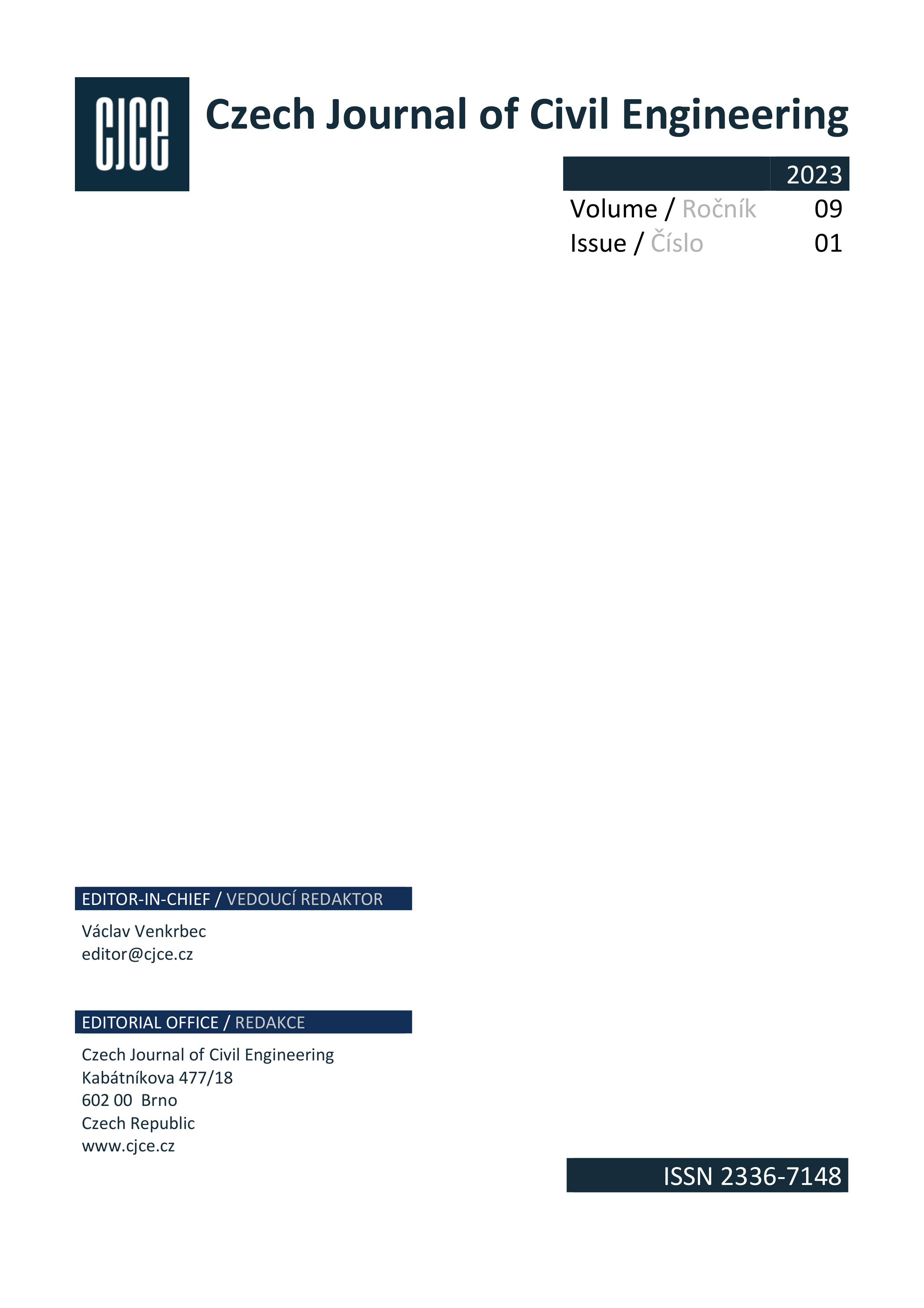Data-oriented approach for moisture reduction in heritage buildings
DOI:
https://doi.org/10.51704/cjce.2023.vol9.iss1.pp23-34Keywords:
Data collection methodology, capillary moisture, BIM, remedial measures, TLSAbstract
Today, several measurement methods aimed at identifying the moisture level of building structures are used in practice. The measured data can be connected to the information model of the building, resulting in an organized database, which will enable not only a better and more complex evaluation, but will enable the automation of the evaluation with the use of artificial intelligence. The problem is mainly the absence of building information models, which are not available especially for historical objects. In this article, we focus on the creation of a methodology for the systematic collection of data on humidity conditions in the constructions of monumental buildings, which will be the basis for the proposal of appropriate measures for adjustment. The first step is the digitization of the building through photogrammetry or terrestrial laser scanning. The second step is the creation of a building information model. The last step is to connect the information from the measurement with the building information model. Enriching BIM with a data set of moisture records from various buildings can significantly contribute to a better understanding of the degree of wetting, identification of causes and also help to choose appropriate measures based on proposed measures in the past.
Metrics
References
MAKÝŠ, O. 2018, Technológia Obnovy Budov, Ochrana a Oprava Spodných a Obalových Konštrukcií; Spektrum STU: Bratislava, Slovakia, s. 27–80.
CHAREF, Rabia, EMMITT, Stephen, ALAKA, Hafiz, FOUCHAL, Farid, 2019, Building Information Modelling adoption in the European Union: An overview, Journal of Building Engineering, Volume 25, 100777, ISSN 2352-7102, https://doi.org/10.1016/j.jobe.2019.100777
DORE, D., BILLARD, C. and NICOLLE, J., 2018, Combining 3D Modeling, Thermography and Dendrochronology for Assessing Moisture Damage in Historic Buildings, International Journal of Architectural Heritage, vol. 12, no. 4, pp. 602-615.
KRIJNEN, S., BOMMEL, E. van, 2020, A 3D BIM-based tool for assessing moisture risk in historic buildings, Automation in Construction, vol. 111, pp. 103-117.
GIANNAKIS, G. G., VENERI, A. F., KARYPIDIS, E. Z., 2019, Assessing moisture risk in historic masonry structures using thermal and visual imaging techniques, Journal of Cultural Heritage, vol. 39, pp. 117-125.
FABIANI, C., GAROZZO, M., PESCARIN, M., 2017, BIM and IR thermography for energy efficiency and conservation of historic buildings, Energy Procedia, vol. 140, pp. 301-310.
KOPÁČIK, A., ERDÉLIY, J., KYRINOVIČ, P., 2020, Engineering surveys for industry, pp. 1-213, ISBN 978-3-030-48308-1, https://doi.org/10.1007/978-3-030-48309-8
SUCHOCKI, C. 2020, Comparison of Time-of-Flight and Phase-Shift TLS Intensity Data for the Diagnostics Measurements of Buildings. Materials, 13, 353. https://doi.org/10.3390/ma13020353
SUCHOCKI, C., DAMIĘCKA-SUCHOCKA, M., KATZER, J., JANICKA, J., RAPIŃSKI, J., STAŁOWSKA, P., 2020, Remote Detection of Moisture and Bio-Deterioration of Building Walls by Time-Of-Flight and Phase-Shift Terrestrial Laser Scanners. Remote Sensors, 12, 1708. https://doi.org/10.3390/rs12111708
AIRA-ZUNZUNEGUI J. R., SÁNCHEZ-APARICIO M., SÁNCHEZ-APARICIO J. L., PINILLA-MELO J., GARCÍA-MORALES S., 2022, Determination of wood moisture content with terrestrial laser scanner, Construction and Building Materials, Volume 350, 128834, ISSN 0950-0618, https://doi.org/10.1016/j.conbuildmat.2022.128834
DAMIĘCKA-SUCHOCKA, M., KATZER, J., SUCHOCKI, C., 1963, Application of TLS Technology for Documentation of Brickwork Heritage Buildings and Structures. Coatings 2022, 12. https://doi.org/10.3390/coatings12121963
STN EN ISO 19650-1, 2018, Organizácia informácií o stavbách. Manažment informácií s využitím informačného modelovania stavieb (BIM). Časť 1: Pojmy a princípy (ISO 19650-1: 2018)
FUNTÍK, T. a kol., 2018, Building Information Modeling, Vydavateľstvo Eurostav, Bratislava, ISBN 978-80-89228-56-0.
STN EN ISO 19650-2, 2018, Organizácia informácií o stavbách. Manažment informácií s využitím informačného modelovania stavieb (BIM). Časť 2: Fáza dodania aktív (ISO 19650-2: 2018)
FRANZONI, E., 2014, Rising damp removal from historical masonries: A still open challenge, Construction and Building Materials vol. 54, pp. 123-136. https://doi.org/10.1016/j.conbuildmat.2013.12.054
GUOLO E., ROMAGNONI P., PERON F., 2021, Capillary rising damp in Venetian context: state of the art and numerical simulation, Journal of Physics: Conference Series, Volume 2069, 8th International Building Physics Conference (IBPC 2021) 25-27 August 2021, Copenhagen, Denmark, 2069, 012046
MAKÝŠ, O., 2014, Affects of Ventilation Technologies for Fighting Moisture in Baroque Masonry. CTM 2014 – Construction Technology and management 2014, pp. 315-320.
POCHMANOVÁ P., MISAR, I., 2011, Kontrolní metody pro stanovení vlhkosti podkladních vrstev podlah. Dostupé na: https://stavba.tzb-info.cz/podlahy/8050-kontrolni-metody-pro-stanoveni-vlhkosti-podkladnich-vrstev-podlah
FASSINA V., FAVARO M., NACCARI A., PIGO M., 2002, Evaluation of compatibility and durability of a hydraulic lime-based plaster applied on brick wall masonry of historical buildings affected by rising damp phenomena, Journal of Cultural Heritage,Volume 3, Issue 1, pp. 45-51. https://doi.org/10.1016/S1296-2074(02)01158-5
LUBELLI B., HEES, R.P.J.v., R., GROOT, C. W.P., 2006, Investigation on the behaviour of a restoration plaster applied on heavy salt loaded masonry, Construction and Building Materials, Volume 20, Issue 9, pp. 691-699, https://doi.org/10.1016/j.conbuildmat.2005.02.010.
SARDELLA, A:, DE NUNTIIS, P., BONAZZA, A., 2018, Efficiency evaluation of treatments against rising damp by scale models and test in situ, Journal of Cultural Heritage, Volume 31, Supplement, pp. 30-S37. https://doi.org/10.1016/j.culher.2018.03.020
EUSEBI V, MONTAGNA R, PAURI M, STAZI A., 1994, Recovery of rising-damp damaged masonry: experimental comparison between ‘slow diffusion’ and ‘under pressure’ procedures for waterproofing agents. In: Shrive NG, Huize A, editors. Proc 10th IB2MAC, Calgary, Canada, July 5–7, pp. 819–28.
PRÍDALOVÁ, Z., 2013, Prieskumy na návrh sanácie vlhkého muriva, Availibe on: https://www.asb.sk/stavebnictvo/zaklady-a-hruba-stavba/obvodove-konstrukcie/prieskumy-na-navrh-sanacie-vlhkeho-muriva
SASS, O., VILES, H.A., 2006, How wet are these walls? Testing a novel technique for measuring moisture in ruined walls, Journal of Cultural Heritage, Volume 7, Issue 4, pp.257-263. https://doi.org/10.1016/j.culher.2006.08.001
HEALY, W. M., 2003, Moisture sensor technology-a summary of techniques for measuring moisture levels in buildling envelopes. ASHRAE Trans. 109:232. https://www.proquest.com/scholarly-journals/moisture-sensor-technology-summary-techniques/docview/192512842/se-2
ČSN P 73 0610. 2000, Hydroizolace Staveb, Sanace Vlhkého Zdiva, Základní Ustanovení.
WITZANY, J., 1999, Poruchy a Rekonstrukce Zděných Budov; ČKAIT: Prague, Czech Republic.
Downloads
Published
How to Cite
Issue
Section
License
Copyright (c) 2023 Tomáš Funtík, Patrik Šťastný, Ján Erdélyi, Richard Honti

This work is licensed under a Creative Commons Attribution-NonCommercial-NoDerivatives 4.0 International License.
Creative Commons Attribution-NonCommercial-NoDerivatives 4.0 International Public License
Articles published in Czech Journal of Civil Engineering are licensed using Creative Commons License. Except where otherwise noted, individual articles in the Czech Journal of Civil Engineering are licensed under a Creative Commons Attribution-NonCommercial-NoDerivatives 4.0 International (CC BY-NC-ND 4.0).









